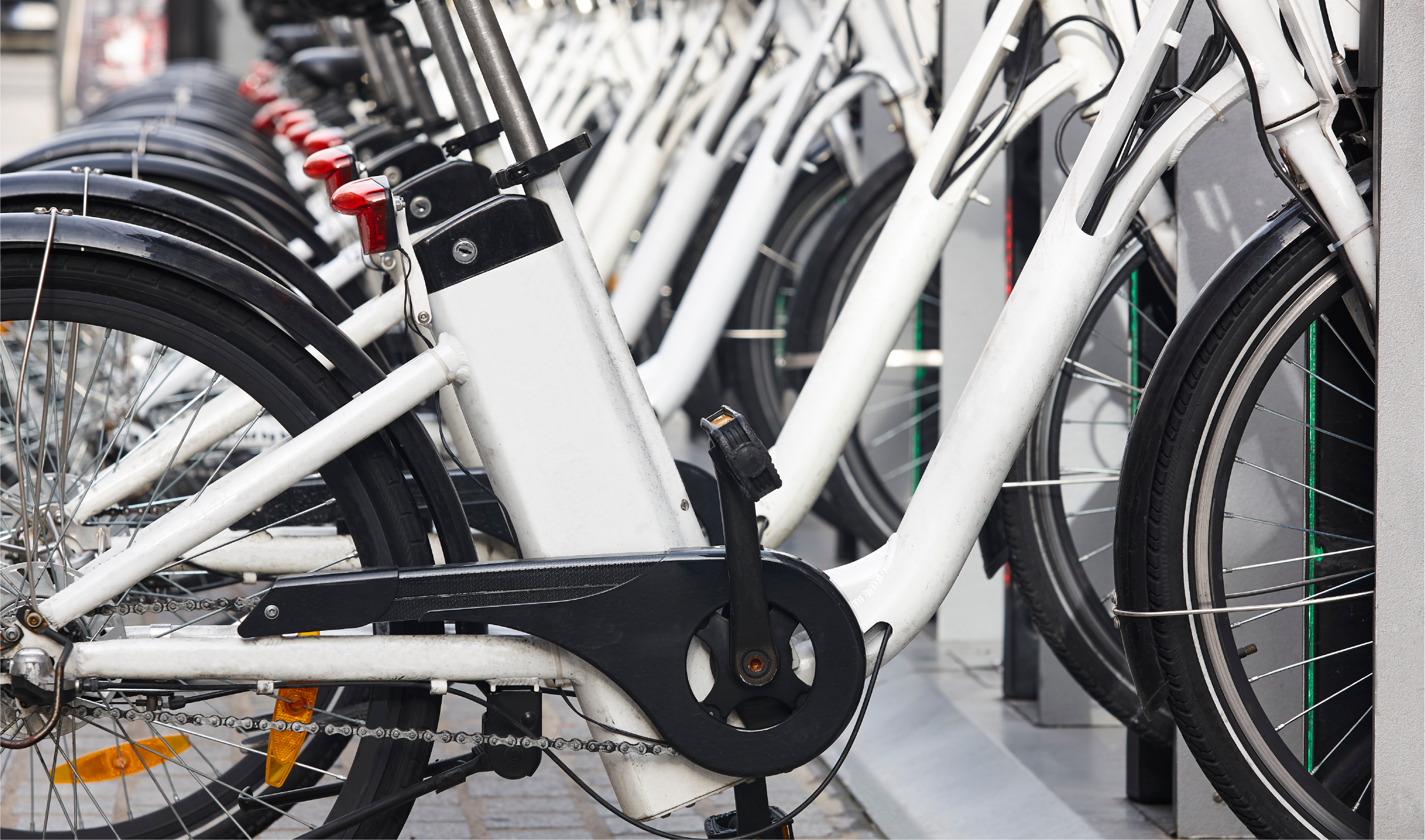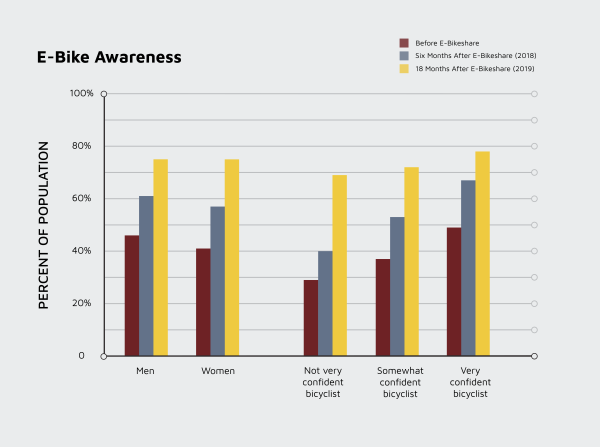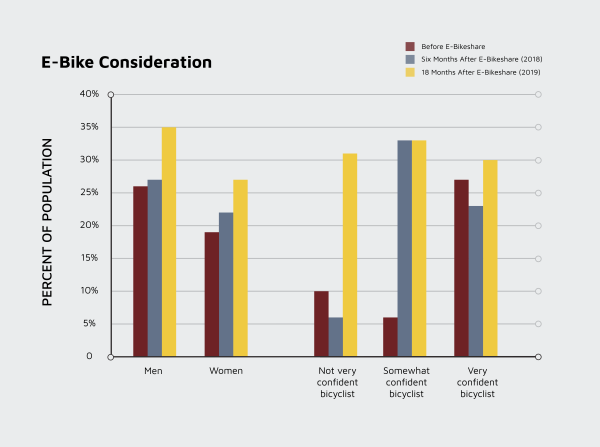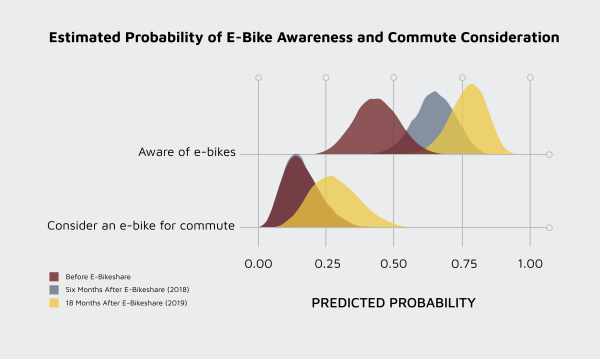
When It Comes to E-Bikes, Seeing Is Believing
E-bikes can be a good alternative to driving: Bikeshare can make more people aware of them.
If you’ve tried one, you know that electric-assisted bicycles, or e-bikes, have some important advantages over regular bicycles. They are faster, meaning you can go farther in the same amount of time. They also require less of your energy, especially going up hills or starting up from a stop. For many people, and particularly older people or people with certain physical limitations, an e-bike can mean the difference between bicycling or not. If e-bike trips replace driving trips, the e-bikers and everyone else benefit from reductions in greenhouse gas emissions and improvements to public health.
So how do we get more people on e-bikes?
A necessary first step is to increase awareness of e-bikes. Bikeshare systems that rent e-bikes could be one way to accomplish that. These systems give people both direct exposure to e-bikes (when they rent them) and indirect exposure (when they see others who have rented them pedaling around). To test the idea that a bikeshare system can raise awareness, we took advantage of the opening of such a system in the Sacramento area (including the city of Davis, where we work). The system was operated by JUMP (at the time a subsidiary of Uber) from its opening in May 2018 to its closing in March 2020 due to the COVID-19 pandemic. The system offered short-term e-bike rentals through per-trip fees or a long-term subscription.
Compared to other U.S. cities, Davis has a strong culture of bicycling for everyday travel. The compact size of the city, its flat topography, and its usually mild (though sometimes very hot) weather make bicycling a viable way to get around all 12 months of the year. The city built the first bike lanes in the U.S. in 1967 and, over the years, has extended its network to 50 or so miles of on-street bike lanes and another 50 or so miles of off-street shared-use paths. Even after excluding students, bicycling rates are impressive by U.S. standards: 47% of UC Davis employees who live in the city bicycled to campus on a typical day in 2019.
On the flip side, this means that 53% of employees living in the city did not bike to campus, two-thirds of whom drove alone to campus instead. This drive-alone group, which by our estimates is over 4,000 people and represents 19% of all employees, is a prime target for the university’s efforts to reduce driving. Since they live in Davis, by definition they live no more than 5 miles from campus, a reasonable biking distance for some but an even more reasonable e-biking distance for many. Getting any of these drivers to switch to e-bikes would help the university meet its targets for reducing greenhouse gas emissions.
Every year we conduct a Campus Travel Survey at UC Davis that asks students, staff and faculty about how they get to campus. Back in 2017, even before the JUMP system opened, we had already been curious about e-bikes and about use and awareness of them in the campus community.
Then JUMP arrived, and gave us a unique opportunity to study bikeshare’s impact on e-bike awareness, and to study, in turn, if awareness made people more likely to consider using e-bikes. The JUMP system served not just Davis but also central Sacramento and West Sacramento, and offered dockless (or free-floating) bikes, which could be rented through the JUMP or Uber apps. The bikes had three gears and were pedal-assisted up to 15 mph. Between 100 and 200 e-bikes were available in Davis at any given moment. Although the rules specified that users park bikes adjacent to bike parking racks when finished with their ride, in practice users parked and rented them anywhere in the service area, meaning they could be seen in many parts of Davis. Most important for our purposes is that the bright red bikes were hard to miss.
To assess changes in awareness, we took the same e-bike questions we had asked in 2017, about six months before bikeshare arrived, and posed them twice more: once in fall 2018, about six months after bikeshare opened, and again in fall 2019, about 18 months after. Our “target group” was university employees living in Davis who either drove or were driven to campus and who were able to ride a bicycle.
We first asked, “Do you know what an electric assist bicycle is? They are also known as “e-bikes.” This question gave us a simple yes/no measure of e-bike awareness. Anyone who responded “yes” was asked two follow-up questions: “Have you ever thought about riding an e-bike to campus?,” (a yes/no measure of e-bike consideration) and “Have you ever ridden an e-bike?” (another yes/no question). In the 2018 and 2019 surveys, after bikeshare had arrived, we added one more question: “Have you used JUMP bike share?” The surveys also included questions about socio-demographics, about how confident respondents felt riding a bicycle (from not at all to somewhat to very), and about their attitudes toward travel, including their agreement with the statement “I like riding a bike.”
A huge JUMP between awareness and consideration
Before JUMP, only 43% of the target group said that they knew what an e-bike was. Only 5.5% had ever used one. Six months later, with JUMP in town, awareness had increased to 58%, and after another year, it had grown to 75%. Awareness increased among groups who tend to bicycle the most: more confident riders and men. But it also increased among other groups. Less confident riders also became more aware as the program went on, and after 18 months, their awareness of e-bikes almost equaled that of the very confident bicyclists. Before JUMP, women were less aware than men of e-bikes, but their awareness roughly equaled that of men by the third survey.

Before JUMP, only 43% of the target group said that they knew what an e-bike was. After 18 months, it had grown to 75%

People from households with children were far more aware of e-bikes than people from households without children, but both groups saw substantial increases in awareness. Respondents who found travel to campus stressful or did not like riding bikes saw the largest increases in awareness. After we controlled, in a statistical model, for the tendency of some groups to be more e-bike-aware at the outset, we found that the odds of being aware of e-bikes six months after shared e-bikes became available was around three times the odds before they were available. Eighteen months after bikeshare, the odds were around 4.4 times the odds before.
Figure 1. E-Bike Awareness
Figure 2. E-Bike Consideration
After e-bikes arrived, people were also more likely to consider using them to commute, although the increase in consideration was neither as large nor as fast as it was with awareness. Before JUMP came to Davis, just over 21% of all of those who were aware of e-bikes, equal to 11% of the target group, said they had thought about riding an e-bike to campus. Six months after shared e-bikes became available, these proportions rose to 23% and 12%, respectively, and after 18 months rose to 30% and 16%. This is a small increase relative to the substantial increase in awareness. In this case consideration for commuting increased less for less confident bicyclists and did not change much for very confident bicyclists. The share of women considering e-bike commuting increased slightly with each survey, while the share for men at first saw little change and then had increased after 18 months. By the time of our last survey, a significant gap in consideration remained between women and men. Our analysis shows that, after accounting for the tendency of some groups to be more likely to have considered commuting by e-bike than other groups from the outset, consideration had not increased six months after e-bikes arrived but had increased after another year.
As another way to illustrate our findings, we used our statistical model to estimate the likely changes in awareness and consideration that would have occurred in a “typical” respondent living in Davis during this time. We defined a typical respondent as a female staff member with no children who was not a very confident bicyclist and had an average liking of biking and stress levels when commuting to campus. For this typical survey respondent, e-bike awareness increased from 43% before shared e-bikes to 65% six months after shared e-bikes became available, then to 77% after another year. Her consideration of using e-bikes for commuting began at 15% and was virtually unchanged six months after shared e-bikes became available, but increased to 27% after 18 months.
Consideration of e-bike commuting also differed if our typical respondent had ridden an e-bike versus if she hadn’t. If she hadn’t, her median probability of considering an e-bike would be 15%, but if she had, her median probability would be much higher at 38% (though this probability is considerably more uncertain and could be as low as 10% or as high as 75%). In other words, experience e-biking, while important, is not likely on its own to lead someone to consider commuting by e-bike. Across the whole target group, the share of respondents reporting having ever ridden an e-bike remained virtually unchanged between 2017 and 2019, suggesting that availability of e-bikeshare had a limited effect on e-bike experience.
Here’s a fun tidbit from our data: A small number of respondents said they had used JUMP bikes but had not ridden an e-bike. Does this mean that some people did not realize that the JUMP bikes had electric-assist? We don’t know if this is the case or if this strange finding stemmed from the way we asked our questions. What we do know, however, is that if the JUMP bike’s battery had died during their ride, they would definitely have noticed the difference, as those red bikes were far heavier than a normal bike.
Figure 3. Estimated Probability of E-Bike Awareness and Commute Consideration
Moving Toward Adoption
The arrival of the e-bikeshare system in Davis appears to have made UC Davis employees who rely on cars substantially more aware of e-bikes, and modestly more willing to consider using e-bikes to commute. It makes sense that consideration lags awareness, in that awareness is simply a first step toward — but not a guarantee of — the process of acquiring knowledge about e-bikes that might eventually lead people to consider or even adopt them for commuting. The notable increase in consideration in the second period of our study, following essentially no increase in the first, suggests that this process can take some time. If the e-bikeshare system eventually returns to Davis, residents will have more opportunities to try an e-bike, potentially increasing their interest in using e-bikes for commuting or otherwise. The substantial increase in awareness over 18 months is a significant finding that planners from the university and the city could leverage in developing programs to encourage e-bike adoption.
Consideration will only follow awareness if commuters see e-bikes as feasible and useful. Not everyone does. In our surveys and others, cost is the most commonly reported barrier to e-bicycling, followed by worries about theft. With this in mind, programs aimed at reducing costs — whether they subsidize e-bike purchases, offer long-term e-bike rentals, or subsidize bikeshare membership — could help more people to consider using them. California is launching a rebate program for e-bike purchases in summer 2022, and a national program is also in the works. Concerns about theft can be addressed, by providing secured bike parking facilities or e-bike rentals with insurance policies.

Consideration will only follow awareness if commuters see e-bikes as feasible and useful.

One particularly interesting question for future research revolves around the events that have transpired since our last survey closed. We have seen news reports of skyrocketing e-bike sales during the COVID-19 pandemic; more e-bikes could mean more visibility on city streets (if the newly purchased e-bikes are actually ridden), which might increase awareness of e-bikes (if people notice that they are e-bikes) and — perhaps nudged by high gas prices — might also lead more people to adopt e-bikes. We don’t know yet — but we’re hopeful.


